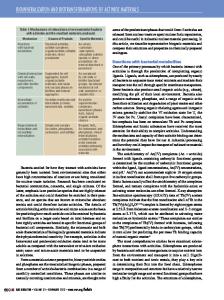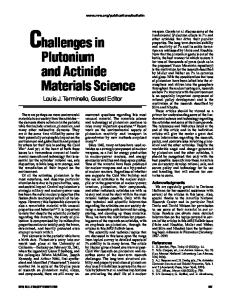Computational modeling of actinide materials and complexes
- PDF / 745,954 Bytes
- 7 Pages / 585 x 783 pts Page_size
- 87 Downloads / 381 Views
Introduction The work horse for most condensed-matter calculations is density functional theory (DFT).1,2 While the theory can be exactly formulated for a homogenous electron gas, it can be applied to any “real-world” material for approximation of the electron exchange and correlation energy (Exc). In view of its humble beginnings, it is remarkably successful in describing the chemical bonding in many elements, compounds, and alloys throughout the periodic table. For example, equilibrium lattice constants are often within 1% of measured values. The local density approximation of the Exc is reasonable for systems with slowly varying electron densities such as d-transition metals,3 while the more recent generalized gradient approximation (GGA) was shown to give a better description4 of the actinides. Apparently, no GGA can simultaneously be accurate for all atomic properties without sacrificing precision for solids with slowly varying electron densities.3 This illustrates the difficulty in devising a completely general assumption of the Exc that is applicable for solids with strongly different electron densities. The atomic volumes of the actinide metals can be used to highlight the difficulties of DFT. In Figure 1, the measured atomic volumes for the actinide metals are shown with a black line, the 5d-transition metal series with a brown line, and the 4f rare-earth series with a green line. We find that the first part of the actinide series shows great similarity to the d-transition
metal series with a parabolic decrease as a function of atomic number while the second part more resembles that of the rareearth series. The reason is that the 5f electrons are participating in bonding up to Pu, then abruptly withdraw from bonding from Am on, leading to a dramatic volume expansion. These very distinct trends can roughly be modeled by two extremes, one in which the 5f electrons are weakly correlated and forming valence band states and the other with the 5f electrons together with the atomic-like core electrons with no inter-atomic bonding. In Figure 1, we show results from calculations that model the band (blue solid circles) and atomic (red squares) limits of the 5f electron behavior. The blue solid circles (“5f fully bonding”) are obtained from electronic-structure calculations with 5f electrons treated as weakly correlated and part of the valence band with no other electron interactions than that of the GGA. Notice how well this model reproduces the experimental situation for the early actinides (Th–Np), while for Pu, there is no upturn, as shown experimentally, a fact that is partly due to the lack of spin-orbit coupling in the model.5 The red squares are results from calculations identical to the solid blue circles except with the 5f electrons confined to core states. This latter extreme in the 5f electron behavior gives rise to rather good agreement with the heavier actinides from Am and on while failing for the early actinides. Ideally, of course, one prefers to have an approximation to the Exc, which can handle
Per Söd
Data Loading...











